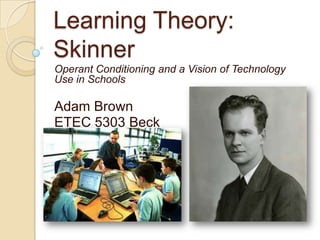
Learning Theory
- 1. Learning Theory: Skinner Operant Conditioning and a Vision of Technology Use in Schools Adam Brown ETEC 5303 Beck
- 2. Operant Conditioning Behaviorist Theory Built upon Ivan Pavlov’s theories of classical conditioning. A process that attempts to modify behavior through the use of positive and negative reinforcement. Through operant conditioning, an individual makes an association between a particular behavior and a consequence. The term “operant conditioning” originated from behaviorist B.F Skinner, who espoused the belief that one should focus on measurable, external and observable causes of behavior rather than internal motivations.
- 3. Positive and Negative Reinforcement Positive reinforcers are favorable events or outcomes that are given to the individual after the desired behavior. This may come in the form of praise, rewards, etc. Negative reinforcers typically are characterized by the removal of an undesired or unpleasant outcome after the desired behavior. A response is strengthened as something considered negative is removed. “Teaching is a matter of arranging contingencies of reinforcement under which students learn.” –B.F Skinner
- 4. Examples in Educational Technology Voluntary response: ◦ Student Studying for an exam using web-based tutorials, textbooks and other resources. Reinforcing stimulus: ◦ Student scores well on the exam and is more likely to explore web-based learning, tools and resources once they see the value they add to the educational experience.
- 5. Views on Teaching and Technology Teaching technologies do not actually teach in the literal sense. They are labor-saving devices that augment and enhance only the aspects that they affect. This allows teachers to spend more time on functions that cannot be duplicated by technology. Example: An instructor uses a learning management system such as Blackboard to organize, present and assess the content of an academic course. This technology augments and enhances the programmed instruction of the student, but cannot replicate the important relationship- building interactions that take place between teacher and student.
- 6. Views on Teaching and Technology Programmed instruction requires that the learner understand each step before moving to the next. The learner needs to stay in one stage until he or she masters the learning objectives to move to the next stage. This instruction is more than simply chunking terminal behaviors and reinforcing them individually. Each new unit of learned behavior should add to already established behaviors in a cumulative way. Example: In a blended learning environment, a student must apply knowledge gained in several hybrid lecture and web-based lessons to a comprehensive project that demonstrates learning beyond remembering such as understanding,
- 7. Views on Teaching and Technology Technology in teaching can help us maximize the development of human potential. Technology assisted teaching is only one means of achieving an educational end. The technology itself should not dictate the direction of the education. Example: An instructor using conferencing technologies, web-based multimedia and a LMS should formulate their teaching strategies based on their pedagogical content knowledge, not by the nuanced realities of the technologies themselves.
- 8. Sources Pai, Young (1973) Teaching, Learning and the Mind. Boston; Houghton-Mifflin. pgs. 94-117 A primer of Operant Conditioning, Reynolds, G. S. Oxford, England: Scott, Foresman. (1975). xiv 155 pp.